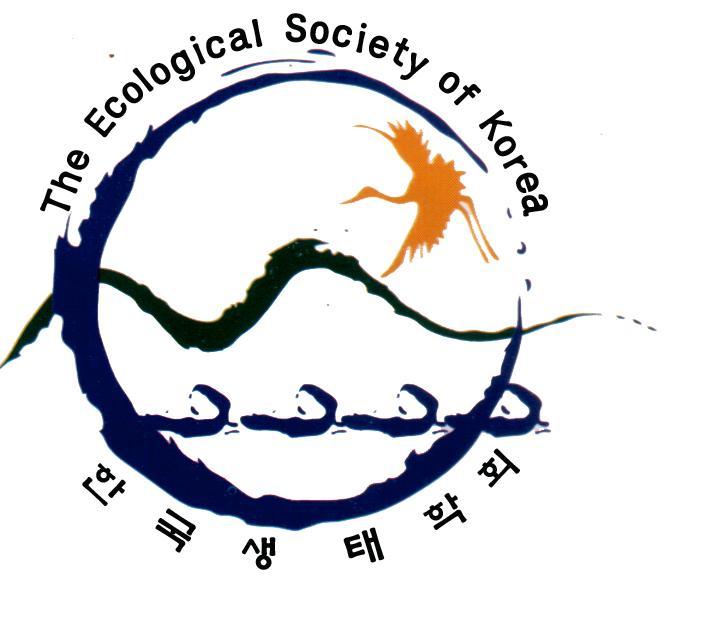- ENGLISH
- P-ISSN2287-8327
- E-ISSN2288-1220
- SCOPUS, KCI
 ISSN : 2287-8327
ISSN : 2287-8327
대구지역 노상식물군락의 분류와 분포 특성
Classification and Characteristics of the Roadbed Plant Communities
김종원 (계명대학교)
Abstract
An important theme of this paper is to search for more genelalities of diversity and distributiones were analyzed by the Zurich-Montpellier Schol's method and generalized habitat characteristics by using Euclidean coefficient and PCoA (Principal Cordinates Analysis). Five plant comunities were classified and matched into largely two physiognomic types: grass-types such as Eragrostis ferruginea community, Eleusine indica community, Setaria viridis community, Digitaria ciliaris community, and forb-type of Plantago asiatica community only. These plant and moisture in microhabitat conditions: stable-moderate, unstable-moderate, stable-dry, and unstable-dry. Top-ten species showing the highest relative net contribution degree(r-NCD) were Digitaria ciliaris, Eleusine indica, Eragrostis feruginea, Plantago asiatica, Echinochloa crus-galli, Trifolium repens, Polygonum aviculare, Setaria viridis, Setaria glauca and Artemisia princeps. The front three species showing more than 50% in percent r-NCD possess florescence after monsoon season. It is critically pointed out that the regional ecological diferentiations i.e. the Daegu bioclimatic division, the C4-plant dominant season(post-monsoon) of Korean peninsula, and species composition diferent from Japan's Plantaginetalia asiaticae, are the basis for deriving characteristics of the roadbed trampled plant communities of Daegu.
- keywords
- C4-plant dominant season(post-monsoon), Daegu bioclimatic division, Phytosociology, Plantagine-talia asiaticae, Ruderal vegetation, Trampled roadbed vegetation안경환김종원 한국생태학회지 제 28 권 제 1 호 32에 발달하고 있는 식물군락에 대하여 이루어졌다 . 한편 노상식물군락에 대한 식물사회학적 연구는 지역 현존식생, C4-plant dominant season(post-monsoon), Daegu bioclimatic division, Phytosociology, Plantagine-talia asiaticae, Ruderal vegetation, Trampled roadbed vegetation안경환김종원 한국생태학회지 제 28 권 제 1 호 32에 발달하고 있는 식물군락에 대하여 이루어졌다 . 한편 노상식물군락에 대한 식물사회학적 연구는 지역 현존식생
참고문헌
(2002) 우리 나라 귀화식물의 발생현황,
(2003[) 통계연보 국토 및 토지이용, 건설교통부
(2003[) 통계자료: 월평년값. [검색 2004년 8월 7일,
(1986) 답압이 질경이의 생장에 미치는 영향,
(2004) 이것이 생태학이다, 월드사이언스
(1998) 논경작지 식생의 군락분류 및 군락생태학적 연구,
(1997) 식생평가지 침:제 2차 자연환경전국기초조사 ,
(1997) 의왕시 자연식생지 편찬을 위한 생태조사연구 최종보고서,
(2004) 제 1 절 식생 및 식물상 부산발전연구원 부산자연환경 조사연구 3차 년도에서, 부산광역시, 부산.
(2002) 식물의 분류학적 정리,
(2003) 지목별 현황 [검색,
(20042004년10월23일]인터넷주소) 일반 현황 [검색, ^대구광역시
(1995) 한국귀화식물원색도감, 일조각
(1998) 외부형태형질에 의한 한국산 질경이속의 분류학적 연구,
(2002) 답압이 설악산 아고산대의 식생에 미치는 영향,
(1996) 원색한국기준식물도감, 아카데미서적
(2004강수량[검색2004년10월23일]) 국토, 기후: 평균기온, 강수량 , 통계청
(1982) Vegetation Miteleuropas mit den Alpen,
(1994) Syntaxonomical and synchorological characteristics of the cool-temperate mixed forest in the Southern Sikhote Alin,
(1996) Some short-lived ruderal plant comunities of non-trampled habitats in North Korea,
(1978) Die straβenbegleitenden Rasengesellschaften im Gebirge Orlick hory und seinen Vorlande,
(1964) Tritgeselschaften auf den Japanischen Inseln, 365-374
(197719901978) Vegetation of Japan Vegetation of Japan Ilustrated Handbook of Japanese Vegetation,
(1991) Plant comunities of trampled habitats in North Korea Journal of Vegetation Science 2,
(2001syn-tax2000) Computer program for data analysis in ecological and systematics,
- 다운로드 수
- 조회수
- 0KCI 피인용수
- 0WOS 피인용수

